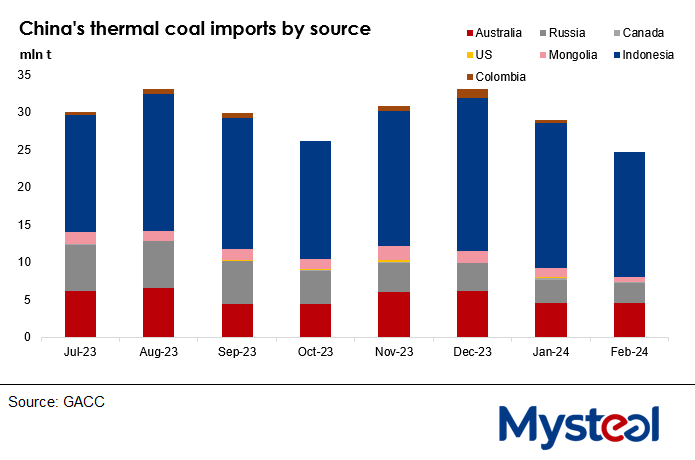Russian thermal coal’s presence in China has been dwindling in recent months, with the country’s thermal coal shipments taking smaller shares in China’s total import mix of the fossil fuel since December last year, Mysteel Global found.
Russia’s thermal coal shipments to China decline further
The latest data from China’s General Administration of Customs (GACC) showed that Russia’s deliveries of thermal coal to China at 2.59 million tonnes in February only accounted for 10.3% of China’s total intakes of the fuel in the month, narrowing for the third straight month since December last year and hitting a new low since May 2022. The shipping tonnage lost 17% on month and 19% on year, according to the GACC data.

Though Russia has remained the third-largest supplier of the fuel to China, the gap of its thermal coal shipments compared with the second-largest supplier Australia widened in February, Mysteel Global noted.
The declining share was partly associated with Russia’s lower coal production as well as the less competitive prices of Russian coal cargoes in China compared with those from other origins, Mysteel Global learned.
Also, some Chinese buyers were shunning Russian coal cargoes due to the payment hurdles as a result of the western countries’ new round of sanctions on Russia since late February, as reported.
As for the Russian government’s brief imposition of flexible export tariffs on coal products from October 1 2023 till end-December of the year that had led to higher import costs for Chinese thermal coal consumers at that time, its impact faded in the opening months of this year as Moscow temporarily excluded major coal types including thermal coal from the taxation list to help boost its coal exports, as reported.
Besides, Russia’s worsened rail transport condition in freezing weather as well as Chinese buyers’ subdued demand due to the Chinese New Year (CNY) holidays over February 10-17 combined to curb China’s intakes of Russian thermal coal over January-February, a market watcher said.
Australian coal supplies to China climb steadily
Australia retained its position as the second-largest thermal coal supplier to China in February, with shipments rising by 1% compared to the previous month and witnessing significant growth from the 134,300 tonnes recorded a year earlier.
The share of Australian coal in China’s thermal coal imports reached 18.5% last month, marking a three-month high and up from a mere 6.5% in March last year as more Australian coal shipments started flowing into China after China lifted its ban on Australian coal imports from January 2023. Though it was still below the average share of 22.2% seen before the ban that began in October 2020.
In the past two months, Australian high-calorific-value thermal coal was pressured down from previous highs amid sluggish coal demand from key buyers like China and India, which largely facilitated Australia’s coal exports.
For example, the price of Australian 6,000 kcal/kg NAR thermal coal (A<13.5%, VM<30, S<0.8%, MT<10%) under Mysteel’s assessment slumped to $123/t as of February 29 from $146/t in end-December last year, on FOB Newcastle basis.
Indonesia remains China’s top coal supplier
In February, Indonesia retained the top place among major thermal coal suppliers to China, delivering a total of 16.56 million tonnes, down by 15% on month but higher by 3% on year. And its share in China’s thermal coal imports ascended to 66.2% last month, hitting a 10-month high.
China’s thermal coal imports from Mongolia and Canada last month plunged by 38% and 16% from January to reach 711,000 tonnes and 163,000 tonnes, respectively, the GACC data showed.
China’s total thermal coal imports slump in February
In February, China’s total imports of thermal coal fell by 16% from January to reach 25.01 million tonnes. The volume, though still being higher by 21% on a yearly basis, has marked decline for the second straight month and hit a one-year low, reflecting China’s eased demand for the fossil fuel amid cooling heating demand among households and suspended industrial activities during the CNY holidays.

For example, power consumed by the country’s secondary industry averaged 476 billion kilowatt hours (kWh) each month over January-February this year, marking a substantial 14.5% decline from December last year, Mysteel Global calculated based on the data from the National Energy Administration.
Written by Tammy Yang










